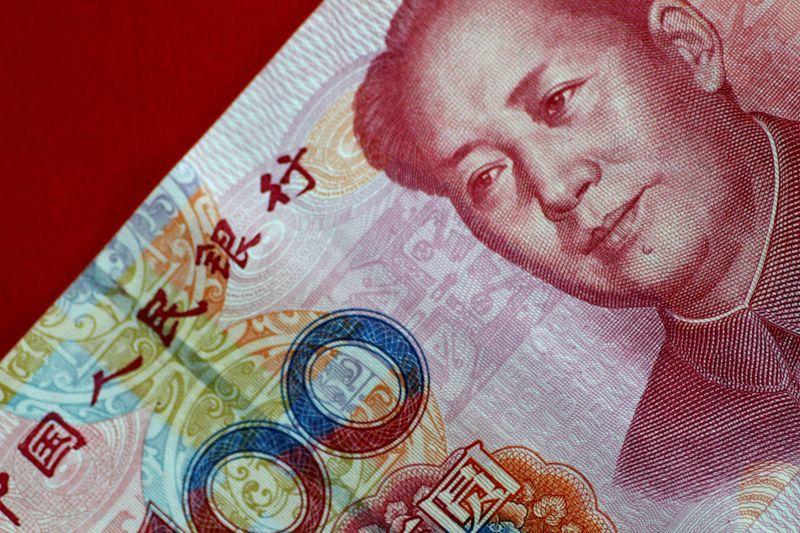By Mike Dolan
LONDON (Reuters) - China's seeming determination to hold the yuan stable in the face of a deflationary asset price bust and capital flight leaves it with an unenviable conundrum familiar in past property crises around the world.
Does it hold the currency steady to prevent a further run on foreign investor confidence? Or should it entertain another export-boosting yuan depreciation as an alternative to the 'internal devaluation' of falling domestic consumer and asset prices already crimping growth?
For now, as government officials publicly state almost daily, it continues to opt for a basically stable exchange rate.
And curiously, the still tightly controlled yuan held firm this week even as authorities moved to ease monetary policy once again to stabilise another alarming lurch lower in China stocks.
For some, the fact that Beijing may be at last ratcheting up piecemeal policy supports to date may be enough of a confidence boost to buoy the currency despite the prospect of lower interest rates.
"Proactive policies can bring more positive impact from the risk sentiment channel, which may overcome the pressure from its yield disadvantage in the near term," HSBC's chief China economist Jing Liu and team told clients.
What's more, expectations of U.S. and European interest rate cuts later this year may also allow China some currency wiggle room - unlike last year when the yuan fell 8% as Chinese rates were cut while western central banks tightened.
But the "sentiment channel" may have to work hard to convince foreign investors - many of whom have removed most all direct exposure to China's markets as they await next steps and try to figure out Beijing's priorities.
And the question of why Beijing would even want a strong yuan at this juncture looms large.
"What are the alternatives for China? One thing is they could devalue the currency - but they don't want to," said Cesar Perez Ruiz, chief investment officer at Switzerland's Pictet Wealth Management, adding he has sold out of China last year and remained on the sidelines with no direct exposure.
"The other thing is to grow exports through internal devaluation of prices and wages - as countries like Spain, Ireland and others did over 10 years ago - but that's not great for growth of the country."
NO EASY OPTIONS
China finds itself on the other side of the boom years of rapid growth and a productivity boom, nursing a popped credit-fuelled property bubble, slowing growth and falling prices.
U.S. corporate, banking and portfolio money is exiting - rattled by geopolitical rifts, bilateral investment curbs, fractured world trade patterns and also a population decline that's sapping future growth potential.
The shock to internal and external investment confidence has led stock prices to nosedive for over a year - underperforming world indexes by more than 30%. And Beijing seems so far either unwilling or unable to resolve the real estate debt problem with sufficient potency, or much inclined to soothe U.S. relations.
Excluding the wild swings of the COVID outbreak in 2020, nominal Chinese economic growth is estimated by some to have ebbed to its lowest since the mid-1970s as consumer price deflation takes hold.
This week's monetary easing via reserve requirement cuts likely tees up more official interest rate cuts ahead - with the 160 basis point yield premium on U.S. Treasuries bonds widening anew.
But with consumer prices falling, the "real" inflation-adjusted policy rate has been rising since August anyway and so overall conditions will have barely eased at all.
"Slow, reactive and insufficient" was how Morgan Stanley analysts described official policy supports before this week.
Shoring up the yuan is at the root of much of the hesitation.
And several reasons are cited for reluctance to pull the currency lever.
The first is fear that signalling a large yuan decline might spook overseas and domestic investors even more and accelerate capital flight - although that appears to be happening anyway as the "internal devaluation" saps asset prices and growth.
Another is a reluctance to re-ignite property excesses or lean back on its export engine, given long-standing goals of re-orienting the economy toward domestic consumption rather than overseas demand.
And yet the alternative option of accepting a housing slide - where many park savings - and a corporate investment drought seemed to have drained local spending anyway.
Long-standing strategic commitment to "internationalise" use of the yuan may make also make it totemic as stable price - even though the currency is not even fully convertible yet and so is still relatively minor as a trading or reserve currency.
Finally, many suspect concerns that any devaluation may reap trade retaliation and restrictions from countries fearful of a new wave of cheap Chinese export competition is another potential barrier to allowing the yuan to slide.
For analysts at CrossBorder Capital, the dilemma is simply all too familiar with property busts of yesteryear - not least
Japan's in the 1980s/1990s, southeast Asia in the late 1990s and even in the United States in 1920s/1930s.
"China is suffering the aftermath of an asset bubble resulting from a misaligned 'real' exchange rate," they wrote.

"Chinese policymakers need to channel adjustment away from domestic prices to avert a deflationary spiral. A major devaluation of the Chinese yuan is needed," they added, suggesting another 10% drop to 8 yuan per dollar is warranted.
The opinions expressed here are those of the author, a columnist for Reuters.